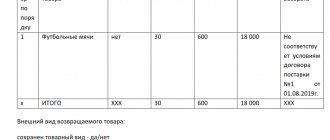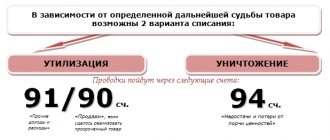Article 5 of the Consumer Protection Law regulates three types of deadlines:
- life time;
- best before date;
- guarantee period.
At the same time, the establishment of a particular period for a product (result of work) depends on its type and nature:
- for durable goods (works), a service life (voluntary or mandatory);
- for goods (works) that, after a certain period, are considered unsuitable for their intended use, an expiration date ;
- All goods (work) may have a warranty period .
This article is devoted to the shelf life of a product (work).
Definition of the concept “shelf life of a product (work)”
The rights and obligations of the manufacturer (performer, seller) in the field of establishing the service life, shelf life of the product (work), as well as the warranty period for the product (work) are established by Article 5 of the Law on the Protection of Consumer Rights (hereinafter also referred to as the Law).
Shelf life is the period after which the product (work) is considered unsuitable for its intended use.
In other words, the expiration date has a prescriptive nature ; its expiration entails the inadmissibility of selling and using the product for its intended purpose.
If a product has an expiration date, the seller must transfer it to the buyer in such a way that before the expiration date of the product it can already be used by the buyer (Clause 2 of Article 472 of the Civil Code of the Russian Federation). In practice, this requirement is very often violated, especially for food products and perfumes and cosmetics. So, for example, a perfume product or decorative cosmetics items may be sold with an expiration date that will expire in half a month or a month, during which the seller, if he purchases this product, may not have time to use it by the expiration date.
Thus, the shelf life of a product has two functions:
- guarantees that the product meets the quality requirements established by the rules binding on the seller;
- establishes a ban on the sale (transfer) of goods by the seller (manufacturer) after the expiration of this period, as well as in the period preceding the expiration of this period, which is insufficient for the buyer to use the purchased product for its intended purpose.
The expiration date is established for goods that are completely consumed during use , the consumer properties of which may deteriorate over time, or for goods that over time may become hazardous to the environment, as well as life and health.
Clause 4 art. 5 of the Law provides for the obligation of the manufacturer (performer) to establish an expiration date for food products, perfumes and cosmetics, medicines, household chemicals and other similar goods (work).
The list of goods that, after expiration of the expiration date, are considered unsuitable for their intended use was established by Decree of the Government of the Russian Federation of June 16, 1997 N 720. However, from January 1, 2021, this Decree of the Government of the Russian Federation has lost force.
Difference between expiration date and warranty period
The shelf life differs from the warranty period in that the warranty period is the period during which the product must meet the requirements for its quality. That is, these two terms differ in the criteria for their determination:
- expiration date - use;
- warranty period - quality.
On the other hand, both of these periods should depend on the use of the product, however, the warranty period directly depends on the use of the product, since the quality of the product changes (deteriorates) as a result of use (normal wear), and the shelf life of the product often does not depend on the fact of use, for example , if the subject of the purchase and sale agreement is food, perfumes and cosmetics, medicines, their expiration date still expires, regardless of whether the buyer has started using them or not.
Your suppliers must also comply with labeling requirements
Good example
The Slippers store and the Women's Slippers supplier have connected EDI. In its goods accounting service, the store receives the UPD from the supplier and confirms acceptance. The EDI operator automatically informs Chestny ZNAK that the batch of women's slippers has a new owner - the Slippers store.
Bad example
And the supplier “Men’s Slippers” did not connect the EDI, but sent a batch of goods to the “Slippers” store and paper invoices for them. The store sees that there is no UPD and hopes that the supplier sent an electronic invoice from his personal account in Chestny ZNAK. The store goes into its personal account in Chestny ZNAK, but there is no document there either. This means that he does not have the right to register men’s slippers, because without a document he will not be able to put the goods on the balance sheet in Chestny ZNAK. If the store does accept the shipment and starts selling it, it will violate the law.
Calculation of product shelf life and indication of expiration dates in documents and on packaging
The manufacturer (seller) is obliged to bring information about the shelf life of the goods to the attention of the buyer in the technical documentation attached to the goods, on labels, markings or in another way adopted for certain types of goods (clause 4 of article 5, clauses 2, 3 Article 10 of the Law on Protection of Consumer Rights).
The shelf life of a product is determined by the period of time calculated from the date of its manufacture, during which the product is suitable for use, or the date before which the product is suitable for use (Article 473 of the Civil Code of the Russian Federation).
On the packaging and in the accompanying documents for the product, either one numerical value (expiration date) or two must be indicated: the duration of the shelf life and the start date of its expiration. In practice, however, in most cases two calendar dates are indicated: the manufacture of the product and the expiration date.
For some types of goods (especially perishable food products, medicines, etc.), the expiration date is set in hours.
Inventory and how to measure it
Inventory is goods located in a store's warehouse and intended for sale. If we are talking about a service sector enterprise, then inventory includes consumables, components and spare parts (inventory in a beauty salon includes cosmetics and hair dye).
Inventories can be divided into:
- current inventory (ensures the store’s daily trade);
- insurance inventory (necessary to minimize direct store losses from failed sales or loss of loyalty of regular customers).
- seasonal (to ensure uninterrupted trade during periods of seasonal changes in demand);
- targeted inventory (to provide targeted events or VIP clients).
Inventory is measured in several ways:
- in kind (for example, 150 packs of cookies);
- in monetary terms (for example, the amount of the warehouse is 750,000 rubles);
- in days/weeks (for example, there will be enough cookies for 3 days of sales).
Expiration date of food products
The concept of “shelf life of food products” is defined in SanPiN 2.3.2.1324-03 “Food raw materials and food products. Hygienic requirements for shelf life and storage conditions of food products. Sanitary and epidemiological rules and standards" (approved by the Chief State Doctor of the Russian Federation on May 21, 2003). This document is a valid regulatory legal act insofar as it does not contradict the requirements of technical regulations and other international legal acts of the Eurasian Economic Union.
The shelf life of food products is a limited period of time during which food products must fully meet the requirements usually imposed on them in terms of organoleptic, physicochemical parameters, incl. in terms of nutritional value, and the requirements established by regulatory documents for the permissible content of chemical, biological substances and their compounds, microorganisms and other biological organisms that pose a danger to human health, as well as meet the criteria of functional purpose.
In accordance with clause 3.1.1. SanPiN 2.3.2.1324-03 the shelf life of a food product is determined by the period of time, calculated from the date of its manufacture, during which the food product is suitable for use, or the date before which the food product is suitable for use. The period of time (date) during which (until which) the food product is suitable for use should be determined from the moment the technological process of its production is completed and includes storage in the warehouse of the manufacturer, transportation, storage in food trade organizations and at the consumer after purchase.
Expiration dates for food products can be indicated in different ways . On this issue, Rosstandart, in a letter dated August 17, 2011 N 130-42/2489 “On the expiration date”, gave the following clarifications:
“In accordance with GOST R 51074-2003 “Food products. Information for the consumer. General requirements”, the expiration date is indicated as follows: “Best before... (hours, days, months, years)”, “Best before... (date)”, “Use (consume) before... (date)”.
We consider it incorrect to indicate the expiration date with the words “no less than”, since in this case the product can be considered suitable for consumption for an indefinitely long time, which stimulates the use of preservatives and creates an obstacle to the use of products with shorter expiration dates.”
In clause 3.1.2. SanPiN 2.3.2.1324-03 contains the following requirements for information on the label about the expiration dates of food products :
“Information on the label about the expiration dates of food products must indicate: hour, day, month, year of production for especially perishable products, products for baby and dietary foods; day, month and year - for perishable products; month and year - for non-perishable products, as well as the rules and conditions for their storage and use.”
Consumer requirements when detecting product defects during the shelf life
In accordance with paragraph 1 of Art. 19 of the Law, the consumer has the right to present the requirements provided for in Article 18 of the Law to the seller (manufacturer, authorized organization or authorized individual entrepreneur, importer) regarding defects in the goods if they are discovered during the warranty period or expiration date.
Thus, a consumer, for example, of a certain food product or cosmetics, who discovers defects in the product during the established shelf life, has the right to demand its replacement with a product of the same or another brand with a recalculation of the purchase price or, for example, refuse to fulfill the sales contract and demand a refund of the amount paid for the goods.
In the event that expiration dates have not been established , the consumer has the right to present the requirements provided for in Art. 18 of the Law, if defects in goods are discovered within a reasonable time, but within two years from the date of their transfer to the consumer, unless longer periods are established by law or contract.
If a product was sold to a consumer after its expiration date , then only the seller can make a claim, since it was he who sold the expired product.
Lack of cash or sales receipt . If, for example, it turns out that a consumer purchased an expired or a product of poor quality, but the cash receipt confirming the purchase was not preserved, this does not mean that there is no point in filing a claim. In accordance with paragraph 5 of Art. 18 of the Law on the Protection of Consumer Rights, the absence of a consumer's cash or sales receipt or other document certifying the fact and conditions of purchase of goods is not grounds for refusal to satisfy his demands.
In accordance with Art. 493 of the Civil Code of the Russian Federation, the absence of a consumer’s cash or sales receipt, electronic or other document confirming payment for goods does not deprive him of the opportunity to refer to witness testimony in confirmation of the conclusion of the contract and its terms.
Thus, if the consumer does not have a cash receipt, but has justified claims to the seller or manufacturer, then the consumer must obtain testimony from persons who can confirm that the consumer actually purchased the goods from this seller. These may be acquaintances who were near the consumer at the time of purchase or saw the consumer leaving the store with the purchase.
Seller's responsibilities
The seller of goods is an organization, regardless of its legal form, as well as an individual entrepreneur who sells goods to consumers under a sales contract. First of all, the seller must have a license to trade, if such a procedure is established in the given territory. The license must be presented to the consumer upon his first request.
The seller must have a sign indicating his name, profile, mode of operation, legal form (affiliation), and legal address. This information helps the consumer have an idea of the seller. In self-service establishments, when they are closed for a lunch break or at the end of work, all customers located in the sales area (department, section) are served.
The seller must warn customers about this 15 minutes before the termination of service. When closing an enterprise for sanitary work, repairs, re-equipment, in connection with its liquidation, the seller is obliged to notify buyers in advance of this with a special announcement 5 days before its closure. The advertisement also indicates the address of the nearest enterprise selling similar goods.
The seller is obliged to maintain the trading floor and warehouse premises in accordance with the technical, sanitary, fire and other requirements established for enterprises of the corresponding type. The enterprise's equipment and inventory must be kept in exemplary sanitary and technical condition. Measuring instruments must undergo mandatory verification by the Federal Agency for Technical Regulation and Metrology. Positive results are certified by an appropriate stamp or verification certificate.
To advertise goods and services, window and interior display cases are used, where samples of available goods are displayed, which are also subject to sale at the request of the buyer. It is necessary that display cases meet sanitary and aesthetic requirements.
By the time of opening, the retail outlet must be prepared for operation: goods are provided with clearly written price labels, their display has been updated, appropriate inventory and packaging materials, and cash registers have been prepared. Prices of goods must be indicated in rubles and only if necessary can additionally be indicated in foreign currency.
Responsibility for selling expired goods
Clause 5 of Art. 5 of the Law prohibits the sale of goods (performance of work) after the expiration of the established expiration date , as well as goods (performance of work) for which an expiration date should be established, but it is not established. Such a product is considered unfit for use. This does not mean that if such a product is used, the consumer will necessarily suffer harm. However, potential danger exists.
The ban on the sale of expired goods is ensured by the norms of the Code of Administrative Offenses of the Russian Federation and the Criminal Code of the Russian Federation.
Administrative liability for violation of the rule of paragraph 5 of Art. 5 of the Law “On Protection of Consumer Rights” is provided for by the following articles and the Code of Administrative Offenses of the Russian Federation:
- Article 14.4 of the Code of Administrative Offenses of the Russian Federation. “Sale of goods, performance of work or provision of services to the population of inadequate quality or in violation of the requirements established by the legislation of the Russian Federation”;
- Article 14.5 of the Code of Administrative Offenses of the Russian Federation “Sale of goods, performance of work or provision of services by an organization, as well as by a citizen registered as an individual entrepreneur, in the absence of established information about the manufacturer (executor, seller) or other information, the mandatory provision of which is provided for by the legislation of the Russian Federation”;
- Article 14.8 of the Code of Administrative Offenses of the Russian Federation “Violation of other consumer rights” covers a wide range of offenses: clause 1 of this article provides for liability for violation of the consumer’s right to receive necessary and reliable information about the product (work, service) being sold, about the manufacturer, about the seller, about the performer and about their mode of operation.
Criminal liability for violating the rules of paragraph 5 of Art. 5 of the Law on the Protection of Consumer Rights is provided for by Article 238 of the Criminal Code of the Russian Federation, according to which a crime is “the production, storage or transportation for the purpose of distribution or sale of goods and products, performance of work or provision of services that do not meet the requirements for the safety of life or health of consumers, as well as unlawful issuance or use of an official document certifying the compliance of specified goods, works or services with safety requirements.”








